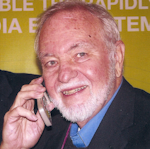Those of you designing short-range wireless systems have no doubt discovered the useful Friis equation for path prediction:
Pr = PtGtGrλ2/16π2d2
Pr is the power received at the antenna, Pt is the transmitted power, Gt and Gr are the transmit and receive antenna gains (power ratios not dB) referenced to an isotropic source, λ is the wavelength of the signal in meters and d is the distance between transmitter and receiver in meters.
You can rearrange this to predict range d:
d2 = PtGtGrλ2/16π2 Pr
This formula is very helpful in predicting performance especially at UHF and microwave frequencies over a line of sight (LOS) link. It pretty much assumes no obstacles and that the antennas are a few wavelengths above the ground. It also assumes the same antenna polarization at both ends. And while it is not a perfect predictor for all applications, it is very helpful.
It also gives some useful insights to the key wireless transmission factors. For example, wavelength is really important. The longer the wavelength or the lower the frequency the greater the range. (λ = 300/fMHz ). That means you will get more range out of a 900 MHz wireless link than one at 2.4 or 5 GHz for the same power level. And this formula really points out the importance of directional antennas. Gain antennas are a relatively simple way to get greater range and link reliability without boosting transmit power or power consumption.
But there are a few other things that really do matter in predicting range and performance. The important one is receiver sensitivity. Receiver sensitivity is generally stated in terms of the minimum power to trigger the receiver circuitry expressed as so many dBm loss. A typical chip radio receiver has sensitivity in the -80 to -110 dBm range. The greater the number the better the sensitivity. Just keep in mind that different methods are used to get that figure and that it is subject to data rate. The lower data rate signals have a better bit error ratio (BER) and a greater receiver sensitivity. So to boost range and path reliability, use the lowest useful data rate for the application.
Another useful formula is path loss.
dB loss = 37 dB + 20log(f) + 20log (d)
Here f is in MHz and d is in miles. To convert meters to miles divide by 0.000621.
Now once you do a prediction on path loss, you can figure out the link budget. Do this in dB/dBm.
The power reaching the receive antenna is:
Pt + Gt + Gr – path loss – fade margin
You want this number to be greater than the receiver sensitivity. If you do not get that result, you should first consider gain antennas as adding transmit power is usually more difficult and costly.
To be really conservative, you could also include a fade margin. Fade margin is an estimate of how weather and other environmental factors may influence the signal. Something in the 5 to 15 dB range is usually good as it gives you that extra margin of safety in the link.
There are other factors to consider. Transmission line loss is horrendous at these frequencies. Coax cable carries the UHF or microwave signal ok, but it attenuates the daylights out of it. Even a few feet can greatly reduce the signal level. So factor that in if you are using longer lines.
Just remember, these guidelines assume a LOS path. If your application requires you to transmit through walls or trees of other obstacles, these formulas won’t be accurate. You can compensate by adding additional path loss figures to the equation but these can vary widely (10 – 30 dB).
One last thing. None of these predictions factor in noise. If you keep the transmit power high, path losses low, and receiver sensitivity high, you can usually overcome the noise that is inherent in any wireless system.
These formulas are very helpful and I have used them numerous times in the past for different wireless applications. Maybe they can help you.
